Monthly Archives: November 2018
Storage share, November 15/16, 2018
- On: November 14, 2018
 0
0
We are ready to wrap up this season. Then we’ll enjoy the winter, with lots of cooking, ice skating and skiing (we hope!) before beginning to plot next year. Have a wonderful Thanksgiving! Beth & Steve
Storage Share this week
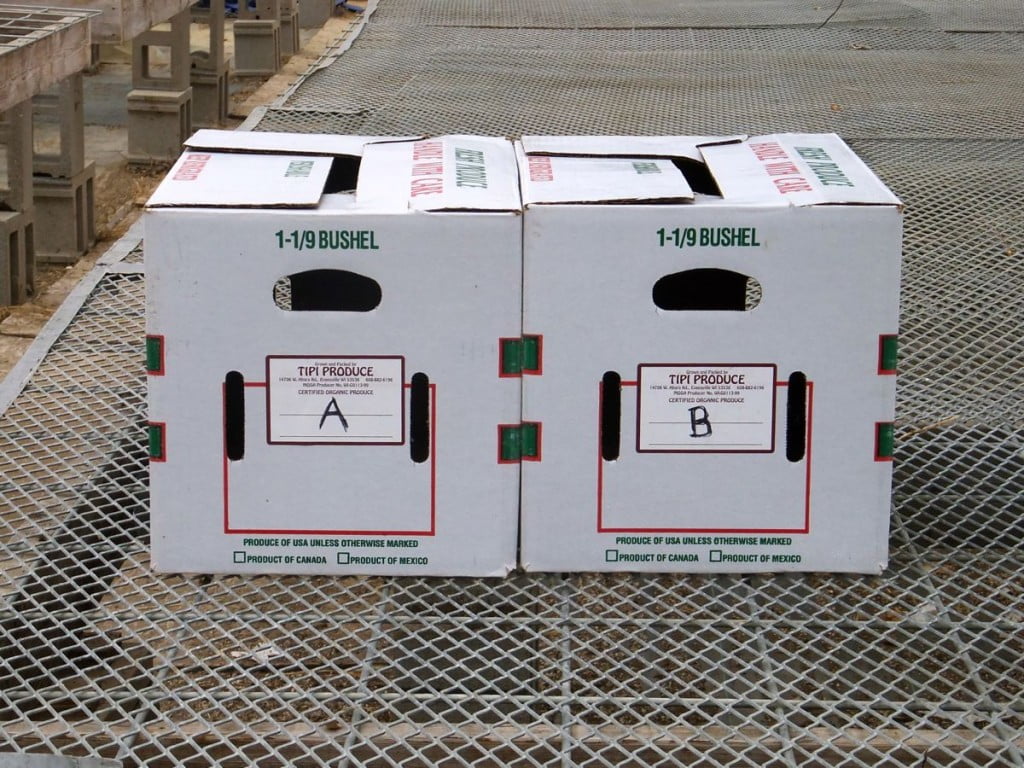
Take one box labelled “A” and one box labelled “B”.
Things you need to know about your winter share
* Your delivery will consist of two different boxes, labeled “A” and “B”. Take one “A” box and one “B” box. The boxes contain different vegetables.
* Please pick up your boxes on the day of delivery, during the normal hours for your site.
* Outpost members, pick up your boxes on Friday. This is the busiest weekend of the year for the Outpost staff, so they WILL NOT hold boxes past Friday, nor can they handle special requests.
* Members at unheated sites, please replace the blankets carefully. That keeps everyone’s produce in good shape.
* The boxes are heavy! Bring lots of bags to take your produce home.
Veggie List and Storage Info (Storage share, Nov. 15/16, 2018)
We hope you enjoy this shipment of veggies. Strategize to use them well, as some will last longer than others.
* These are the most perishable vegetables: kale, cauliflower, Romanesco.
* These are the next-most perishable: Brussels sprouts, cabbage, leeks, turnips and onions. Keep an eye on your butternut, potatoes and sweet potatoes. The last two are susceptible to drying out. Expect the largest butternuts to last the longest.
* These will last the longest: Beauty Heart radish, beets, carrots, celeriac, garlic, parsnips.
Box “A”
Refrigerate everything in this box.
Beauty Heart winter radishes, ~1.5 lb
Beets, 3 lb
Brussels sprouts, on stalk
Carrots, 6 lb total
….. orange ~4.6 lb
….. yellow ~1.5 lb
Celeriac, 1
Green cabbage, 1 medium
Kale
Leeks, ~1 lb
Parsnips, 2.5 lb
Turnips, a few
Mixed Romanesco and purple or green or white cauliflower, 3 – 4 lb total
Box “B”
The Brussels sprouts and onions need refrigeration. Everything else in this box can be stored cool or at room temperature. See notes below for more detail.
More Brussels sprouts stalks
Butternut squash, 6 – 7 lb
Garlic, 2 beautiful bulbs
Potatoes, Amarosa fingerlings, 2 lb
Potatoes, russet, 5 lb
Potatoes, Satina, 5 lb
Sweet potatoes, ~10 – 11 lb
Onions, 5 lb total
….. ~1.5 lb red
….. ~3.5 lb yellow
Beauty Heart radishes (round, white with pale green shoulders and bright pink interior) – Refrigerate. The interior color is lovely. Slice thinly and add to salads, cook lightly in mixed vegetable medleys or cut into matchsticks and add to pasta salads. We enjoy grated carrot and Beauty Heart salads all winter.
Beets – Refrigerate in a bag or container. Beets will store for two months or longer.
Brussels sprouts – Pluck from stalks and refrigerate in a bag or container. Do this the day you pick up your CSA boxes. Eat within 2 to 3 weeks.
Butternut winter squash – You will receive 6+ lbs of squash total. Store your butternut in a cool, dry place. 55 – 60 F is ideal. Do not put in a plastic bag. Expect the largest butternuts to store the longest. Inspect your squash frequently and cook promptly if you see any soft spots developing. You can cook, mash and freeze the squash for future use. I find that you can refrigerate cut raw squash for up to one week. This runs counter to the accepted way to store squash, but is useful if you want to cook just half a squash. Try microwaving your squash for one to two minutes before cutting or peeling. This softens the squash and makes a large butternut easier to handle.
Cabbage – Refrigerate.
Cauliflower (white, purple or green) – Refrigerate in a bag or container.
Carrots, orange. Refrigerate in a plastic bag. Will keep for several weeks.
Carrots, yellow. This variety is pretty AND they taste good.
Celeriac – Will store for months in your fridge. Cut off chunks as needed. Peel before using. I find it easiest to cut the celeriac into flat slices, then peel.
Garlic – Store at room temperature.
Kale – This mature kale is best cooked, rather than used in salads.
Leeks. Refrigerate and eat within three weeks. Leeks are not a long-storage crop. You may need to strip off one or two outer leaves to freshen the leeks before you cook them.
Onions: Refrigerate or store in a cool, dark spot and protect from light. Exposure to light stimulates sprouting. If you have the room, it’s safer to store the onions in the refrigerator. After the wet season, they might not last as long as usual.
Parsnips (These look like large white carrots.) – Refrigerate in a plastic bag. Parsnips will store for two months but will darken in color. That is a harmless change.
Potatoes, fingerlings, russets and Satinas – Can be stored at room temperature or in a cool spot, but must be kept in the dark so they do not turn green. A cloth or loose plastic bag draped over the paper bag will help avoid moisture loss, but do not close the plastic bag. All three types will store longer if kept cool. Around 40 – 50 F is ideal. The potatoes were grown by the Igl family near Antigo.
Amarosa fingerlings – This is a new addition to the Storage share for us. These fingerling potatoes have red skin, marbled red flesh and a creamy, velvety interior when cooked. They are delicious fried, baked, boiled, or steamed. Fingerlings really shine when simply roasted. Cut in half, oil well and roast at 400 F until soft. Don’t try to make mashed potatoes; they will turn gluey.
Russets– We got the big ‘baking’ grade so you have nice bakers for Thanksgiving. Excellent for baked or mashed potatoes.
Satinas– These are good all-purpose potatoes, everything from roasted to potato salad. I really like this variety of yellow potato because they oven-roast so well and because they are less sweet than other yellow varieties such as Yukon Golds.
Sweet potatoes – These are a mix of the Beauregard and Covington varieties. All types have developed excellent flavor and sweetness. Store at room temperature, no lower than 55 F, but 60+ F is better. Keep them on your kitchen counter where it’s easy to keep an eye on them. I like to keep ours in a paper bag so they don’t dehydrate. Cook promptly if they start to soften. The roots come in a wide ranges of sizes and all are good.
Turnips (white roots with purple shoulders and white interior) – Refrigerate. Scrub clean but do not peel. Excellent roasted, or mashed or scalloped with potatoes.
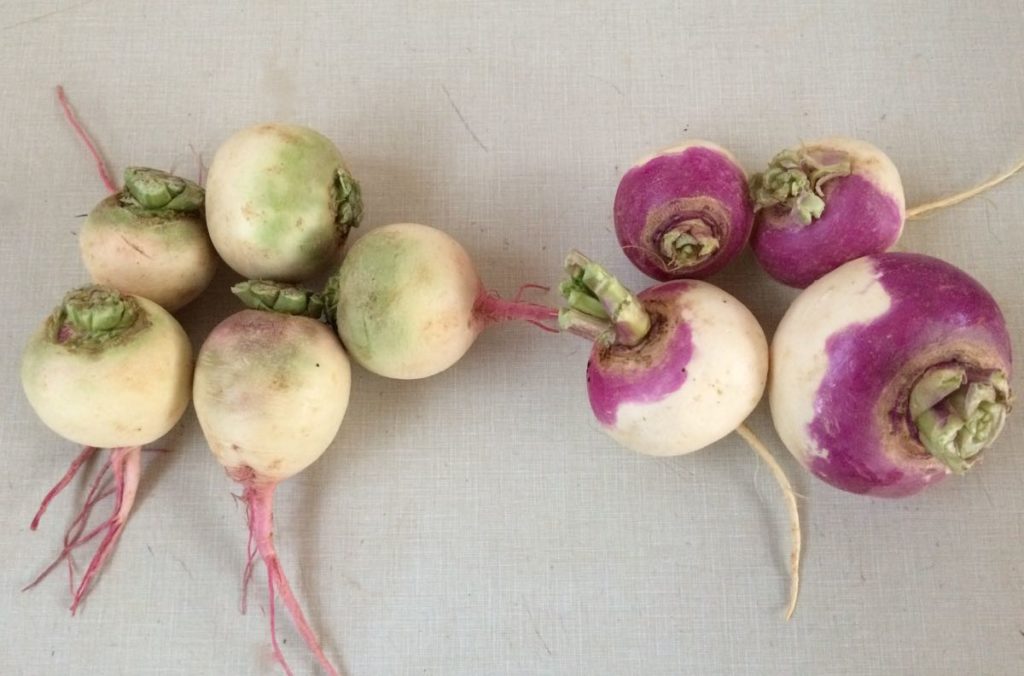
Beauty Heart winter radish (left) and turnips (right).
These roots look similar but are quite different. Beauty Hearts are winter radishes with a beautiful magenta interior. Their shoulders are green, white or blush pink. In contrast, turnips (right in photo), have purple shoulders and a white interior.
What are you cooking for Thanksgiving?
We are creatures of habit when it comes to Thanksgiving. Here are our plans so far:
– brined roast heritage turkey from our friends Jen and Bryce Riemer (Beth),
– Brussels sprouts with garlic-mustard vinaigrette (Steve),
– roasted sweet potatoes with garlicky yogurt sauce (Sophie),
– glazed butternut squash (Beth),
– crunchy carrot-Beauty Heart salad with sesame-seed dressing (Steve),
– some kind of slow roasted onion relish (Beth),
– homemade applesauce (Ari), and
– apple pie (Sophie).
I’ll probably make stuffing with lots of celeriac and onions but that might be overkill. Yeah, we tend to go overboard. We love celebrating Thanksgiving and the end of harvest season.
Menu Ideas
This is a great time of year to gather recipes to enjoy all winter. Online cooking sites post Thanksgiving menus and recipes, many suited to your Storage share vegetables. Peruse and bookmark the recipes soon; Thanksgiving collections are taken down quickly after the holiday.
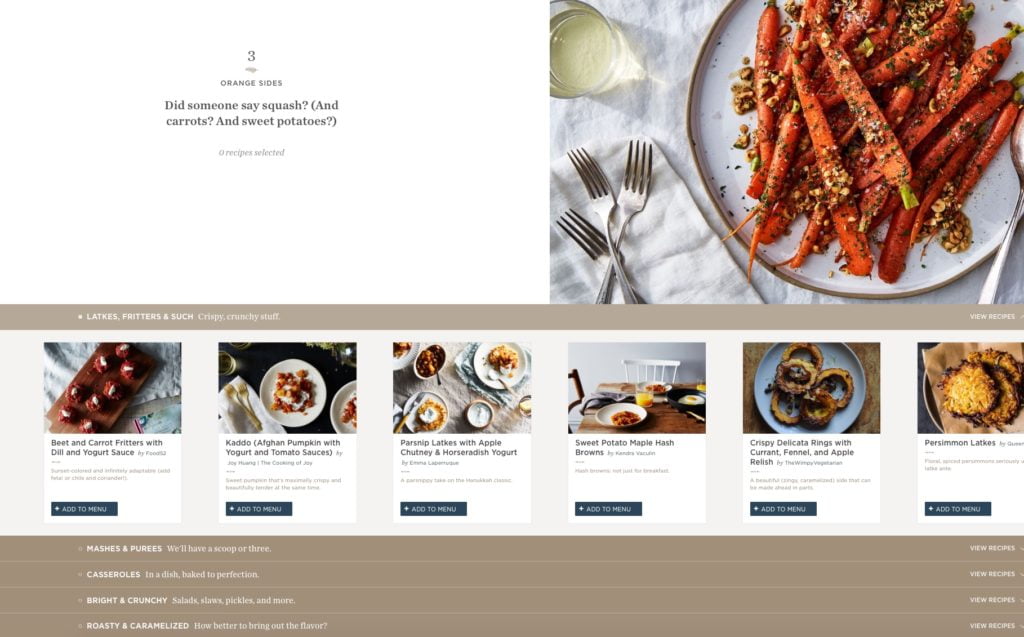
Food52’s Thanksgiving Menu Maker.
♦ IMHO, the lively Food52.com site has the best Thanksgiving recipe collection this year, possibly of all time. It’s titled AutoMagic Thanksgiving Menu Maker, and is beautifully organized by type of dish. Go straight to Section 3, “Orange Sides”, with multiple subheadings such as “Bright and Crunchy Salads” or “Roasty and Caramelized.” Move on to “Something Green” or “Gravies & More” or other tempting sections. I plan to gather a suite of recipes to try this winter.
♦ Smitten Kitchen is our go-to site for dessert recipes but has excellent veggie recipes too. Blogger Deb Perelman often posts her own plans for new Thanksgiving feast. This year, she has simply posted a collected list of Thanksgiving recipes from previous years. It is extensive!
♦ 101cookbooks. Always has good vegetarian and whole-grain recipes.
♦ The Dishing Up the Dirt site doesn’t have a specific Thanksgiving section, but many of her recipes are tailored to Storage share produce.
♦ Finally, remember that we can use Local Thyme recipes all winter. Check them out for Thanksgiving ideas.
Extension share, Nov. 8, 2018
- On: November 07, 2018
 0
0
Such a busy week
Temperatures are dropping sharply tonight, and tomorrow night, and every night for the next week. This brings a sudden end to our field season. We hustled all week to finish our field work. It has been a sprint.
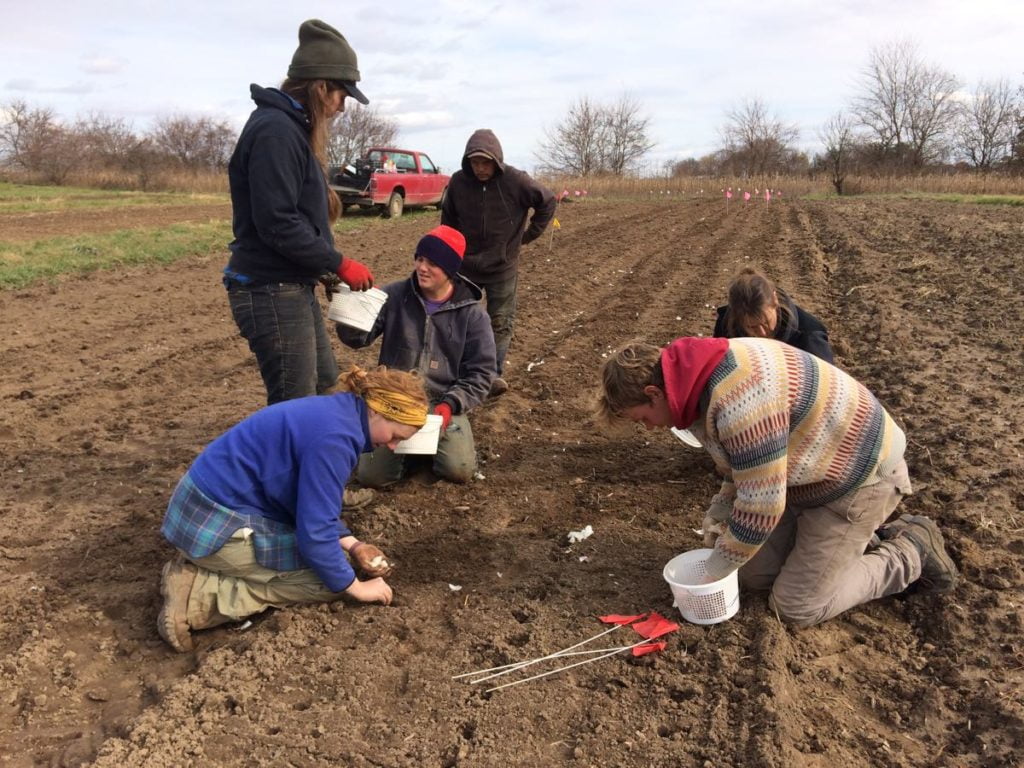
Garlic planting. We planted much more garlic than usual, with plans of having more garlic for the CSA boxes next year. First, I chose our best garlic bulbs. Then we cracked them into individual cloves. Each clove will grow into one bulb. We’ll mulch the field with straw soon, to protect the plants from fluctuating temperatures this winter.
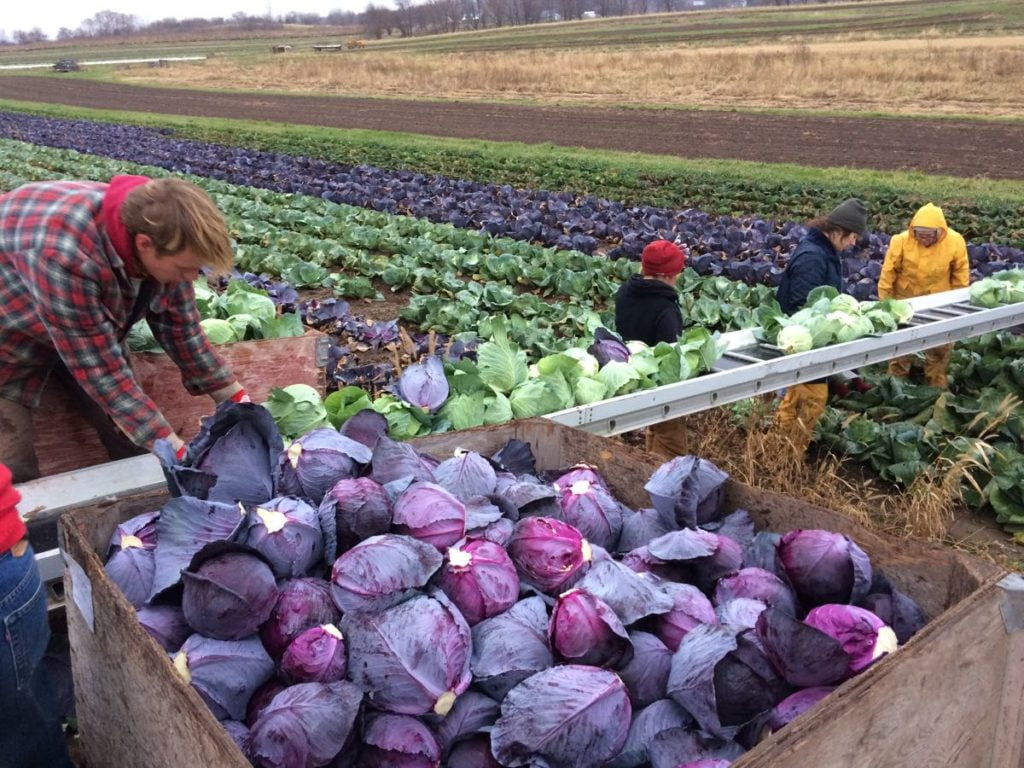
Cabbage harvest. The heads are small this year, but almost all are perfect. This is good news. After the rainy summer and fall, we worried there would be rot in the cabbages but it has not been a problem at all. We also harvested all the remaining broccoli, cauliflower and Romanesco. We’ve been waiting for these cool-loving crops to size up, but they are out of time.
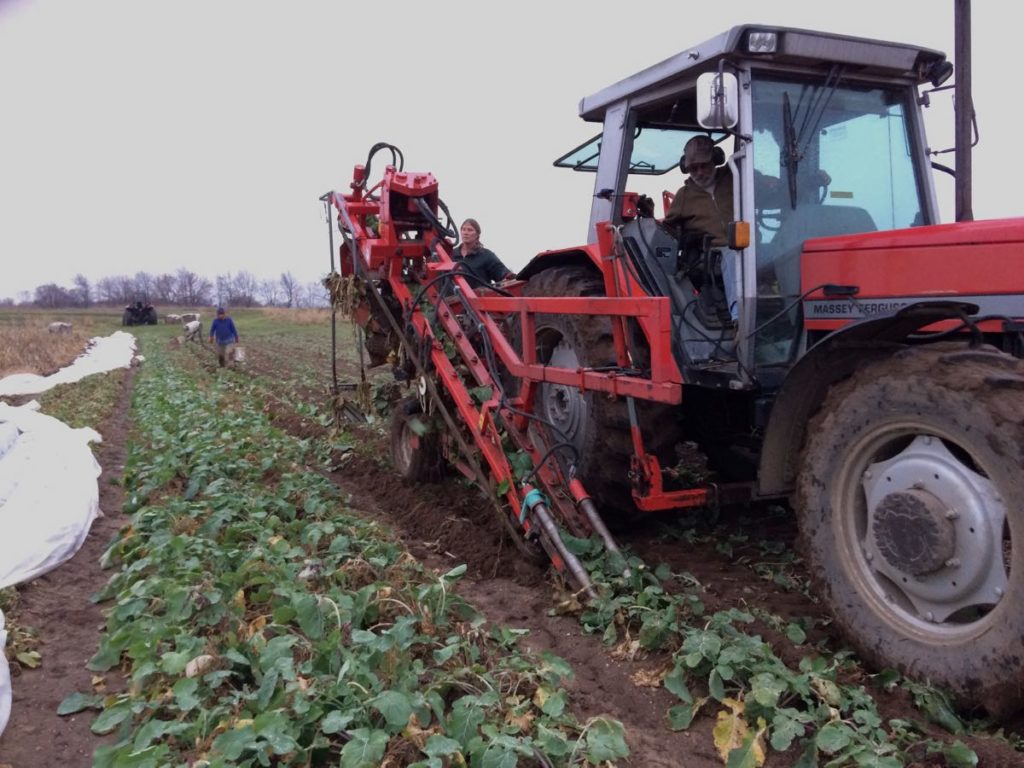
Rutabagas were our final root harvest for the year. Steve cleaned the harvester thoroughly this afternoon. Tomorrow, he’ll take it to the neighbor’s shed for the winter.
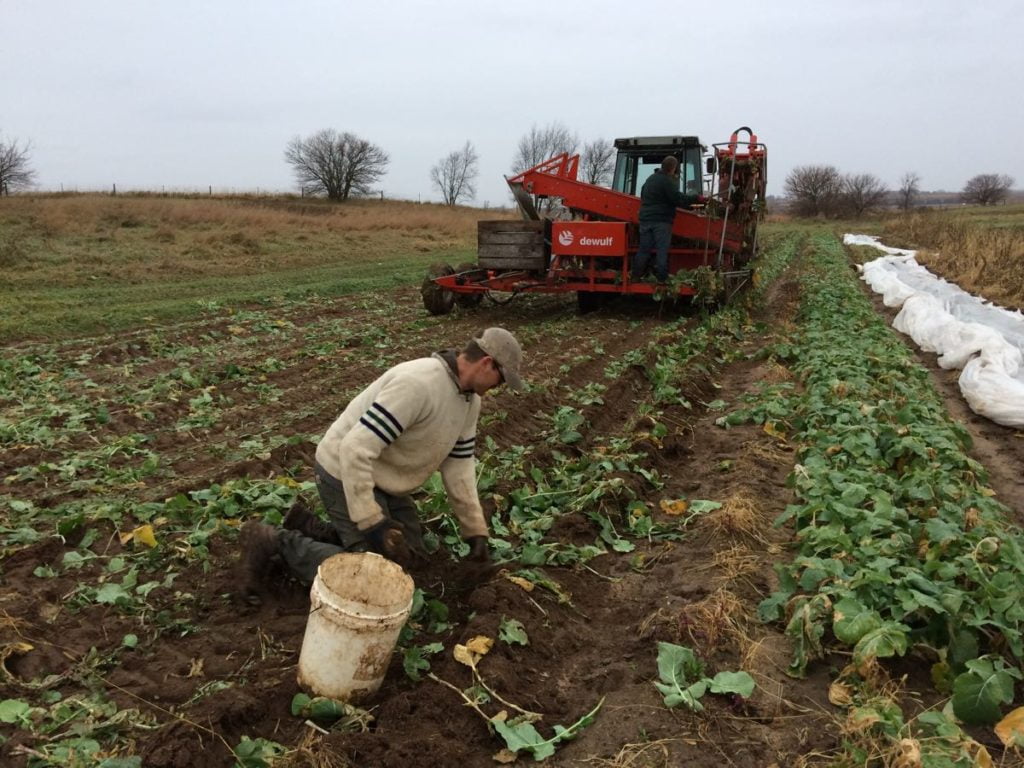
Even with a mechanical harvester, we still pick up dropped roots by hand. It’s worth our time.
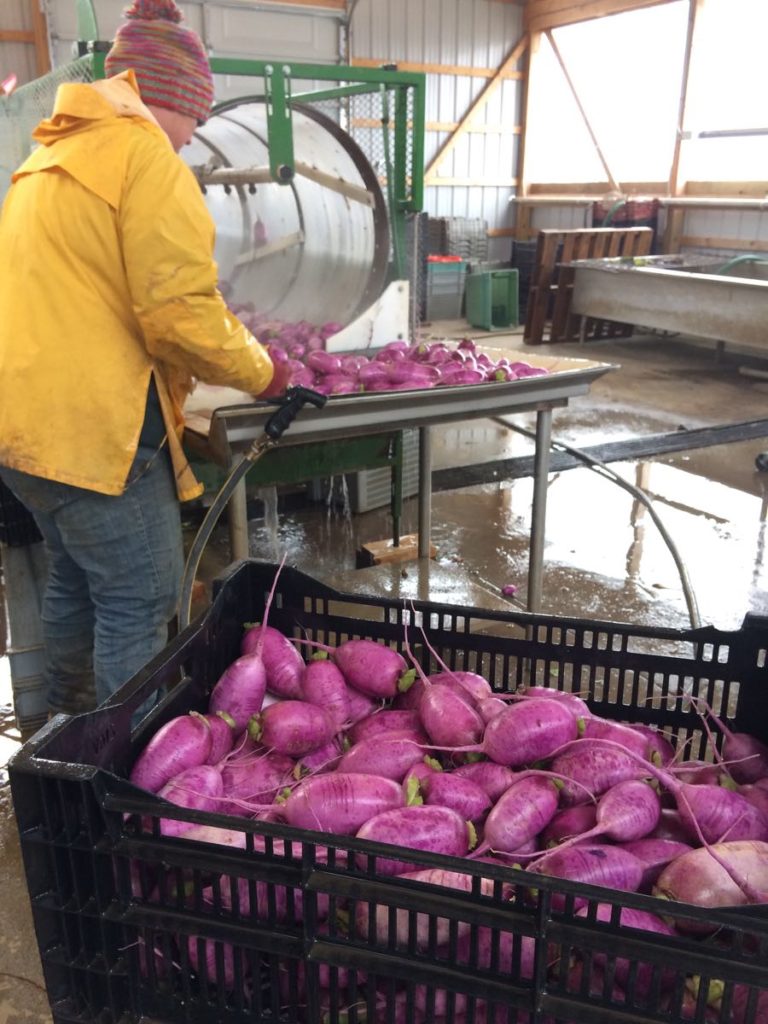
Maggie washes beautiful purple daikon for you.

Our farm cat Charlotte abandoned her kittens on Monday, leaving me to bottle-feed them during a very busy week. I don’t look too dismayed, do I? Charlotte evaded capture when we got cats neutered earlier this year but we’ll try again. Both kittens are available for adoption.

Daylight saving shortens our work days. We will finish a few harvests tomorrow, then our outdoor work in finished for the season! Beth
Veggie List and Veggie Notes
Extension Share, Nov 8/9, 2018
Sweet potatoes, ~2.5 lb
Butternut squash, 1 medium or 2 small
Portobello mushrooms, 2 – 3
Savoy cabbage, 1 medium
Carrots, 2 lb
Beets, 2 lb
Red mustard greens, 1 bunch
Purple daikon, a few
Broccoli OR cauliflower, about 1 lb total
Yellow onions, ~3
Portobello mushrooms – These beauties are from Mary at Hidden Valley Mushrooms in the Wisconsin Dells. We will pack them in brown paper bags. Mary says to store them in your fridge in the paper bag. Eat soon; they are fresh, lovely and perishable.
Purple daikon – These Korean radishes are so pretty. Slice or cut into matchsticks to add to cabbage or carrot salads.
RECIPES
Visit our 2018 Recipe Log or our 2017 Recipe Log or join our Facebook discussion group.
LOCAL THYME/ Comforting Classics
Moroccan Sweet Potato Soup
Braised Cabbage with Prosciutto
Chickpea Salad with Roasted Beet and Sunflower Seeds
Mustard Green Caesar with Chicken or Chickpeas
LOCAL THYME/ Outside the Box Recipes
Sunny Curried Sweet Potato Salad
Pasta with Cabbage and Meat Sauce
Beet and Cabbage Kraut
Mustard Greens and Turkey Salad
LOCAL THYME/ Quick & Easy Meal
Breakfast Bahn Mi Sandwich with Daikon and Carrot Pickles
LOCAL THYME/ Daikon recipes from July
Cabbage and Daikon Fried Rice
Curried Daikon
Fish and Cabbage Tacos with Quick Pickled Purple Daikon
RECIPES FROM LAUREN
BUTTERNUT SQUASH & BEET PIZZA
Adapted from Half Baked Harvest
I love love love the pizza dough recipe linked to below (by Pioneer Woman). It is my go to crust every single time I make pizza. I especially love it because it doesn’t only prefer to be made in advance, it actually gets better the longer you wait to use it. I am always making a batch on Sunday and waiting until Thursday or Friday to make a quick pizza. The way it slow ferments in the fridge makes a perfect crust every time (plus no kneading necessary!). If you don’t want to make a crust at least 24 hours in advance, than I recommend you use whatever recipe works for you quickly or getting a batch of store-bought dough instead. Lauren.
Serves 4-6
Takes 1 hour, 15 minutes
1/2 batch favorite pizza dough (see note above)
2 tablespoons olive oil
1 tablespoon maple syrup
1/2 teaspoon red pepper flakes
1/4 teaspoon cinnamon
3 cups cubed butternut squash
2 cups cubed beets
3 tablespoons butter, divided
2 yellow onions, thinly sliced
1 cup apple cider
1 tablespoon flour
1 cup warm whole milk
1/4 teaspoon Kosher salt
1/4 cup finely shredded Parmsean
1 apple, thinly sliced
1 ounce blue cheese
1 cup shredded Gouda cheese
- At least a day before you plan to make this pizza, make the pizza dough. Unless you have a quicker crust you prefer (see note above).
- Preheat the oven to 425 degrees.
- In a small bowl whisk together 2 tablespoons olive oil, maple syrup, cayenne, red pepper flakes and cinnamon.
- Spread the squash and beets out on a single layer and drizzle with olive oil mixture. Toss to coat. Roast in preheated oven for 25 minutes.
- Melt butter in a large skillet. Add onions, cook over medium heat for 10 minutes until softened. Add cider slowly (about 1/4 cup at a time) so that each addition soaks into the onions, caramelizing them slightly, before adding more. Cook onions until caramelized to your likely, about 20 minutes total.
- Meanwhile, prepare your sauce. Melt remaining butter in a small saucepan over medium heat. Add flour and whisk until incorporated. Let bubble and brown slightly for a minute. Reduce the heat to medium low and add the warm milk and salt. Stir consistently for the next 5-10 minutes until thickens into a thin sauce. Add Parmesan.
- Roll out dough into the size of your pan (round or rectangle will both work fine). Spread sauce over crust followed by half the roasted vegetables. Evenly distribute onions, apples and blue cheese over crust followed by the remaining roasted veggies and finally the shredded cheese.
- Bake for 30 minutes until crust is golden and crisp.
.
SWEET POTATO BIBIMBAP
Serves 4-6
Takes 1 hour
2 cups water
1 teaspoon Kosher salt, divided
1 cup brown rice
2 tablespoons white miso paste
2 tablespoons olive oil
4 cups cubed sweet potato
2 tablespoons butter
1/2 pound portabella mushrooms, sliced
3 cloves garlic, minced
1-inch ginger, peeled and minced
1 bunch mustard greens, ends trimmed and thinly sliced
2 tablespoons toasted sesame oil
2 tablespoons sesame seeds
1 daikon, cut into matchsticks
1-2 carrots, cut into matchsticks
Soft-boiled or fried eggs, optional
Sauce:
2 tablespoons tamari
1-2 tablespoons sriracha
1 tablespoon sugar
1 tablespoon water
1 tablespoon rice wine vinegar
1 tablespoon toasted sesame oil
- Preheat oven to 425 degrees.
- In a medium saucepan, bring water and 1/2 teaspoon salt to a boil over high heat. Once boiling, add the rice. Reduce to a simmer, cover, and cook for 45-50 minutes until rice has absorbed water.
- On a baking sheet, combine sweet potatoes, olive oil and white miso as best you can. There will likely be some small chunks of miso in places. Don’t worry about that too much. Roast in preheated oven for 25 minutes until browned.
- In a large heavy skillet, melt butter over medium heat. Add mushrooms and remaining 1/2 teaspoon Kosher salt. Saute for 10 minutes until softened but still maintaining some bite. Remove to a small bowl.
- Add garlic and ginger to the same pan you cooked the mushroom in. No need to wipe it out (you don’t want to lose any of those delicious mushroom juices). Saute for 2 minutes over medium low heat until fragrant. Add mustard greens. Wilt over medium heat for 2-3 minutes. Add toasted sesame oil and saute 3 minutes longer. Finish with sesame seeds and continue cooking until greens are as wilted as you like.
- In a small bowl, whisk together sauce ingredients. Use 1 tablespoon sriracha if you aren’t a big fan of spice. Use the full 2 tablespoons if like a bit of heat.
- Serve cooked rice with sweet potatoes, mushrooms, greens, raw radish, raw carrot, a drizzle or two of sauce, and a cooked egg if you please.
.



